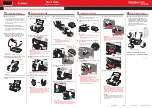
5 Introduction to imaging plate technique
KaVo Scan eXam One
29
5 Introduction to imaging plate
technique
5.1 Imaging plate
Imaging plate is a film-like thin, flexible and
wireless phosphorescent plate, which works as a
wireless receptor. Imaging plate is better than film
because:
•
no need for film development chemicals and
darkroom.
•
tolerates wider range of exposure values,
both overexposure and underexposure are
practically eliminated.
•
All benefits of digital images.
Imaging plate sizes:
•
0 child
•
1 small adult
•
2 large adult
•
3 bitewing
•
4C occlusion
The support base material is black plastic. On top of
the base material is blueish photo-stimulable layer
(does not contain any prosphor/phosphorus). On
top of the blueish material is a top coat protective
layer and the edges are closed with lacquer.
The phosphorescent side of the plate records and
stores the image. This side is sensitive and should
be protected against dust and dirt.
Visible light clears the image information from the
plate, so it must be protected from ambient light
between exposure and processing.
Even when packed properly, the image starts to
fade out slightly within time.
Sensitive side
1.
Protective (topcoat)
layer
2.
Photo-stimulable layer
3.
Support material layer
(=back side, black)
Approved:
Reviewed: Jalkanen Joni 2017-02-13 16:00
Reviewed
See PDM system to determine the status of this document. Printed out: 2017-03-17 10:35:17
D510414, 5
Copyright © by PaloDEx Group Oy. All rights reserved.
















































